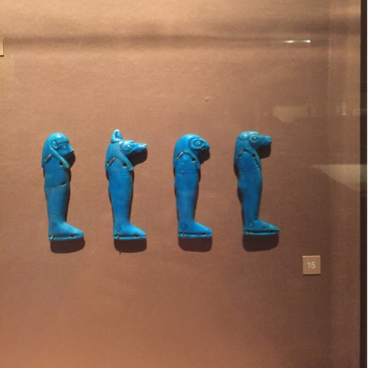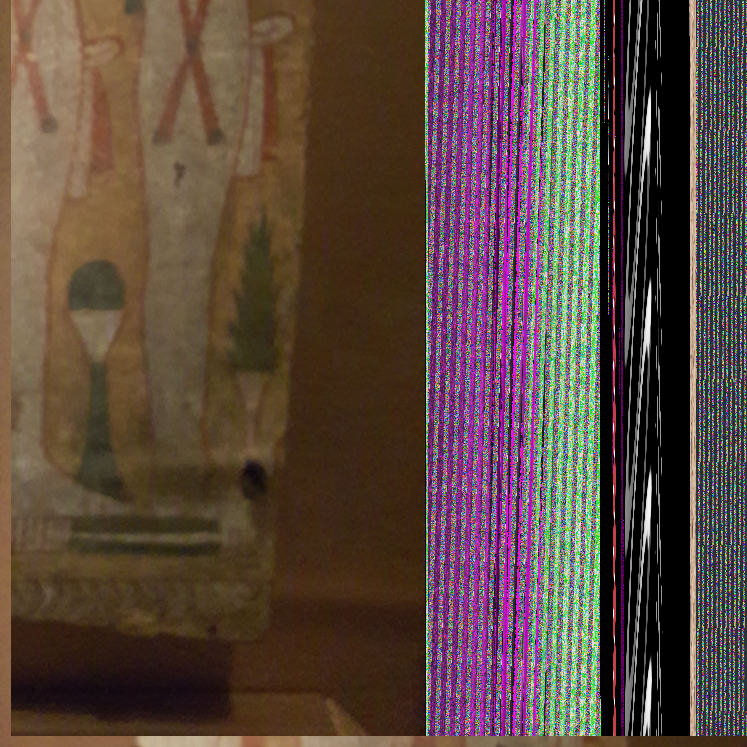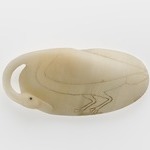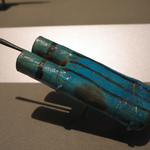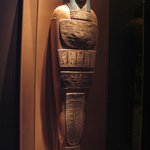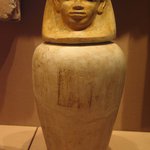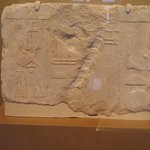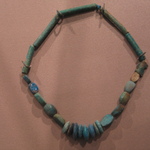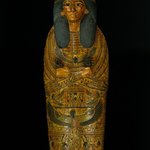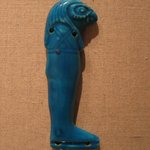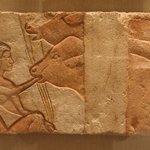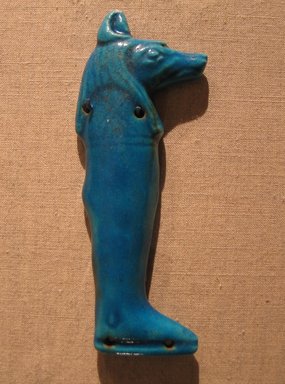

One of the Four Sons of Horus, ca. 664–after 30 B.C.E. Faience, 4 5/16 in. (11.0 cm). Brooklyn Museum, Charles Edwin Wilbour Fund, 51.223.2. Creative Commons-BY (Photo: Brooklyn Museum, CUR.51.223.2_wwgA-3.jpg)

One of the Four Sons of Horus, ca. 664–after 30 B.C.E. Faience, 4 5/16 in. (11.0 cm). Brooklyn Museum, Charles Edwin Wilbour Fund, 51.223.2. Creative Commons-BY (Photo: Brooklyn Museum, CUR.51.223.2_mummychamber.jpg)
One of the Four Sons of Horus
Egyptian, Classical, Ancient Near Eastern Art
On View: Funerary Gallery 2, Martha A. and Robert S. Rubin Gallery, 3rd Floor
Living persons wore only one or a few amulets at a time, but mummies usually bear many amulets. The Ma’at amulet (no. 2) and heart scarabs (nos. 1, 3, 11), which occurred in many forms, guaranteed a successful judgment of the dead. The amulets of a hand (no. 8), lungs and a windpipe (no. 12), and wadjet-eyes (i.e., “healthy” eyes; no. 4) protected those parts of the body and also had connotations of resurrection and the unity or integrity of the mummy. The enigmatic aper amulet (no. 13) takes the form of the hieroglyph meaning “to be equipped,” perhaps in reference to the mummy’s preparation. The two crowns (nos. 5, 6) were symbols of power. The Heh insignia (no. 7), like the popular ankh-sign, denoted eternal life. Among the living, the frog (no. 9) and possibly also the hare (no. 10) suggested fertility. The amulets of the Four Sons of Horus (no. 15) perhaps served, as they did with canopic jars, to protect various organs of the body.
MEDIUM
Faience
DATES
ca. 664–after 30 B.C.E.
PERIOD
Late Period to Roman Period
DIMENSIONS
4 5/16 in. (11.0 cm) (show scale)



COLLECTIONS
Egyptian, Classical, Ancient Near Eastern Art
ACCESSION NUMBER
51.223.2
CREDIT LINE
Charles Edwin Wilbour Fund
CATALOGUE DESCRIPTION
This is one of a set of four "Sons of Horus" plaques in deep blue faience. Pierced twice at base and twice on upper body for attachment. Reverse of figure is flat and undecorated.
EXHIBITIONS
MUSEUM LOCATION
This item is on view in Funerary Gallery 2, Martha A. and Robert S. Rubin Gallery, 3rd Floor
CAPTION
One of the Four Sons of Horus, ca. 664–after 30 B.C.E. Faience, 4 5/16 in. (11.0 cm). Brooklyn Museum, Charles Edwin Wilbour Fund, 51.223.2. Creative Commons-BY (Photo: Brooklyn Museum, CUR.51.223.2_wwgA-3.jpg)
IMAGE
installation, West Wing gallery A-3 installation, CUR.51.223.2_wwgA-3.jpg. Brooklyn Museum photograph, 2005
"CUR" at the beginning of an image file name means that the image was created by a curatorial staff member. These study images may be digital point-and-shoot photographs, when we don\'t yet have high-quality studio photography, or they may be scans of older negatives, slides, or photographic prints, providing historical documentation of the object.
RIGHTS STATEMENT
Creative Commons-BY
You may download and use Brooklyn Museum images of this three-dimensional work in accordance with a Creative Commons license. Fair use, as understood under the United States Copyright Act, may also apply.
Please include caption information from this page and credit the Brooklyn Museum. If you need a high resolution file, please fill out our online application form (charges apply).
For further information about copyright, we recommend resources at the United States Library of Congress, Cornell University, Copyright and Cultural Institutions: Guidelines for U.S. Libraries, Archives, and Museums, and Copyright Watch.
For more information about the Museum's rights project, including how rights types are assigned, please see our blog posts on copyright.
If you have any information regarding this work and rights to it, please contact copyright@brooklynmuseum.org.
RECORD COMPLETENESS
Not every record you will find here is complete. More information is available for some works than for others, and some entries have been updated more recently. Records are frequently reviewed and revised, and we welcome any additional information you might have.




